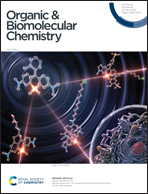Pd-catalyzed three-component [2 + 2 + 1] cycloamination toward carbazoles†
Abstract
Conventional approaches using hydroxylamine derivatives as single nitrogen sources for the preparation of N-heterocyclic molecules rely on two chemical processes involving sequential nucleophilic and electrophilic C–N bond formations. Herein, we report a novel Suzuki reaction/C–H activation/amination sequence for building a myriad of carbazoles in a single transformation using bifunctional secondary hydroxylamines. It is noteworthy that the synthetic utility of this methodology is highlighted by the total synthesis of clausine V and glycoborine by incorporating the title [2 + 2 + 1] cycloamination as the key step. Control experiments were performed to gain a better understanding of the reaction mechanism.
![Graphical abstract: Pd-catalyzed three-component [2 + 2 + 1] cycloamination toward carbazoles](/en/Image/Get?imageInfo.ImageType=GA&imageInfo.ImageIdentifier.ManuscriptID=D4OB00356J&imageInfo.ImageIdentifier.Year=2024)


 Please wait while we load your content...
Please wait while we load your content...